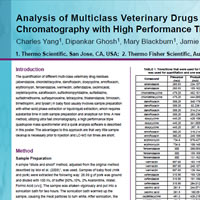
Analysis of Multiclass Veterinary Drugs in Baby Food by Ultra Fast Chromatography with High Performance Triple Quadrupole Mass Spectrometry Authors: Charles Yang1, Dipankar Ghosh1, Mary Blackburn1, Jamie Humphries2, Júlio César Cardoso3 Email (julio.cesar@novanalitica.com.br) 1Thermo Fisher Scientific, San Jose, CA, USA; 2Thermo Fisher Scientific, Austin, TX, USA; 3Nova Analítica, São Paulo, SP, BR |
Resumo do Pôster:The quantification of different multi-class veterinary drug residues (albendazole, chlorotetracycline, danoflozacin, doxycycline, enrofloxacin, erythromycin, fenbendazole, ivermectin, oxfendazole, oxolinicacid, oxytetracycline, sarafloxacin, sulfachloropyridazine, sulfadiazine, sulfadimethoxine, sulfaquinoxaline, tetracycline, thiabendazole, tilmicosin, trimethoprim, and tylosin) in baby food usually involves sample preparation with either solid phase extraction or liquid-liquid extraction, which requires substantial time in both sample preparation and analytical run time. A new method, utilizing ultra fast chromatography, a high performance triple quadrupole mass spectrometer and a quick analysis software is described in this work. The advantages to this approach are that very little sample cleanup is necessary prior to injection and LC-MS run times are short. A simple “dilute and shoot” method, adjusted from the original method described by Mol et al. (2008)1, was used. Samples of baby food (milk and pork) were extracted and transferred to HPLC vials for injection. A calibration solution was made by spiking the multiclass vet drugs into both the neat solution and the mentioned matrices with a calibration curve range from 10ppm - 0.5ppt depending on the compound starting solution. A portion of the matrices was tested for possible contamination of veterinary drugs. To enable rapid data review and analysis, the new software TraceFinder with a simplified interface for data review was used. The flagging of samples and compounds helps analysts quickly determine what is a positive hit or even why there is an issue with the sample or compound. Two calibration curves were generated separately. Analysis of the two curves showed which compounds performed better in which matrix due to sample prep and HPLC conditions. The determined Limits of Detection and Quantitation showed that with a small amount of sample injection lowered limits were achieved. With the higher sensitivity of the MS used, we could inject much less sample as proposed in this work. The new approach easily surpasses the current regulated MRLs. This developed method to analyze multiclass veterinary drugs shows: a simple extraction procedure has no issues with lower end detection limits; there is no need to inject larger volumes because of the sensitivity of the MS used; no contamination of veterinary drugs was noticed in either of the matrices used. References
|
